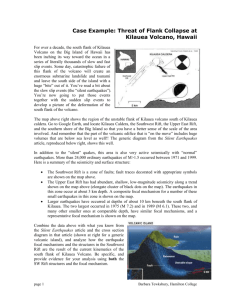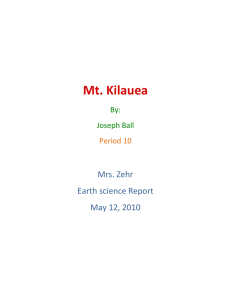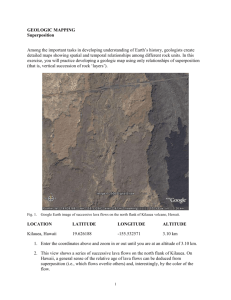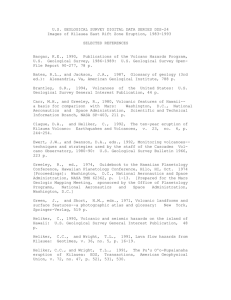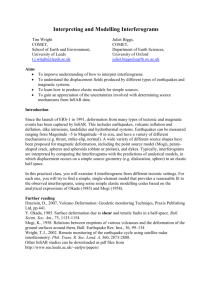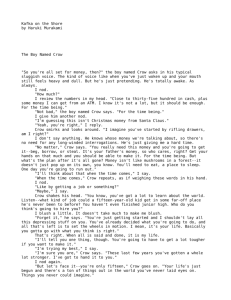2013gl058082readme
advertisement
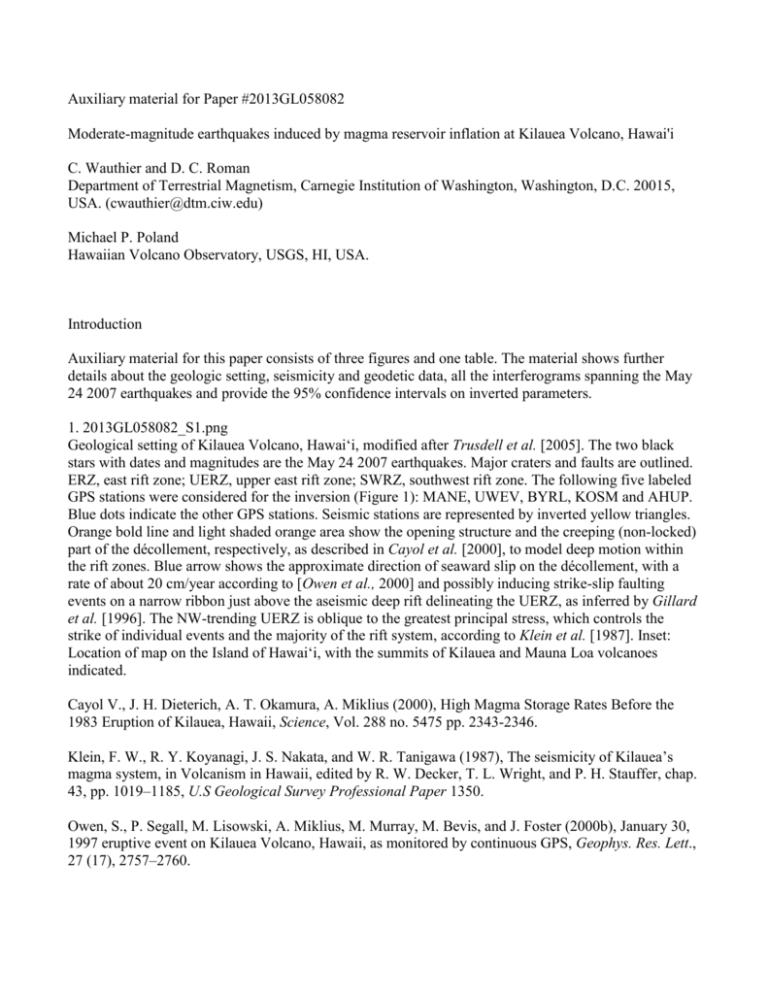
Auxiliary material for Paper #2013GL058082 Moderate-magnitude earthquakes induced by magma reservoir inflation at Kilauea Volcano, Hawai'i C. Wauthier and D. C. Roman Department of Terrestrial Magnetism, Carnegie Institution of Washington, Washington, D.C. 20015, USA. (cwauthier@dtm.ciw.edu) Michael P. Poland Hawaiian Volcano Observatory, USGS, HI, USA. Introduction Auxiliary material for this paper consists of three figures and one table. The material shows further details about the geologic setting, seismicity and geodetic data, all the interferograms spanning the May 24 2007 earthquakes and provide the 95% confidence intervals on inverted parameters. 1. 2013GL058082_S1.png Geological setting of Kilauea Volcano, Hawai‘i, modified after Trusdell et al. [2005]. The two black stars with dates and magnitudes are the May 24 2007 earthquakes. Major craters and faults are outlined. ERZ, east rift zone; UERZ, upper east rift zone; SWRZ, southwest rift zone. The following five labeled GPS stations were considered for the inversion (Figure 1): MANE, UWEV, BYRL, KOSM and AHUP. Blue dots indicate the other GPS stations. Seismic stations are represented by inverted yellow triangles. Orange bold line and light shaded orange area show the opening structure and the creeping (non-locked) part of the décollement, respectively, as described in Cayol et al. [2000], to model deep motion within the rift zones. Blue arrow shows the approximate direction of seaward slip on the décollement, with a rate of about 20 cm/year according to [Owen et al., 2000] and possibly inducing strike-slip faulting events on a narrow ribbon just above the aseismic deep rift delineating the UERZ, as inferred by Gillard et al. [1996]. The NW-trending UERZ is oblique to the greatest principal stress, which controls the strike of individual events and the majority of the rift system, according to Klein et al. [1987]. Inset: Location of map on the Island of Hawai‘i, with the summits of Kilauea and Mauna Loa volcanoes indicated. Cayol V., J. H. Dieterich, A. T. Okamura, A. Miklius (2000), High Magma Storage Rates Before the 1983 Eruption of Kilauea, Hawaii, Science, Vol. 288 no. 5475 pp. 2343-2346. Klein, F. W., R. Y. Koyanagi, J. S. Nakata, and W. R. Tanigawa (1987), The seismicity of Kilauea’s magma system, in Volcanism in Hawaii, edited by R. W. Decker, T. L. Wright, and P. H. Stauffer, chap. 43, pp. 1019–1185, U.S Geological Survey Professional Paper 1350. Owen, S., P. Segall, M. Lisowski, A. Miklius, M. Murray, M. Bevis, and J. Foster (2000b), January 30, 1997 eruptive event on Kilauea Volcano, Hawaii, as monitored by continuous GPS, Geophys. Res. Lett., 27 (17), 2757–2760. Trusdell F.A., E.W. Wolfe and J. Morris (2005), Digital database of the geological map of the Island of Hawaii, United States Geological Survey Data Series 144. 2. 2013GL058082_S2.png Figure S3: a) AHUP–UWEV GPS distance change (black; positive = extension); AHUP vertical change (blue; positive=uplift); KOSM vertical change (red).The red dotted line indicates 17–19 June 2007 ERZ intrusion/eruption. Station locations are given in Figure 1 and S1. Error is smaller than symbols. b) Depth of seismicity vs. time. c) Events per day vs. time (both rift zones, based on data from HVO catalog [Nakata, 2007; Nakata and Okubo, 2008]). Nakata JS (2007), Hawaiian Volcano Observatory seismic data, January to December 2006, U.S. Geological Survey open-file report ; 2007-1073. Nakata JS, Okubo PG (2008), Hawaiian Volcano Observatory Seismic Data, January to December 2007. USGS Open-File Report 2008-1261. 3. 2013GL058082_S3.png Figure S3: Six wrapped, unmasked interferograms showing deformation associated with the 24 May earthquakes. The black dashed line on the time scale indicates the 24 May earthquakes, and the red line notes the Father’s Day (FD) intrusion/eruption. The two black stars on the interferograms shows the locations of the two epicenters. One color cycle represents a 2.8 cm or 11.3 cm Line of Sight (LOS) range change for ENVISAT/RADARSAT-1 or ALOS-1 data, respectively. Main structural features of Kilauea’s summit area are outlined with black lines. 1. Ascending ENVISAT interferogram, IS1 beam (070425-070530), 2. Ascending ENVISAT interferogram, IS7 beam (070504-070608), 3. Ascending ALOS-1 interferogram, (070505-070620), 4. Descending ENVISAT interferogram, IS1 beam (070505070609), 5. Descending ENVISAT interferograms, IS6 beam (070215-070531) and 6. Descending RADARSAT-1 interferogram, (070510-070603). Due to their similar time span, interferograms 2 and 4 are simultaneously inverted with the GPS data to determine deformation source parameters (Figure 1). 4. 2013GL058082_T1.docx Table T1: Best-fit parameters for the preferred model given with 95% confidence intervals. (a) Fixed to the best-fit parameter obtained with a previous inversions with this parameter let free. (b) Fixed to a value inferred from the seismic model after testing in previous inversions with this parameter let free. (c) Poorly constrained parameter which was thus fixed to a realistic value [e.g., Cervelli and Miklius, 2003] Cervelli P. F. and A. Miklius (2003), The shallow magmatic system of Kilauea Volcano, in The Pu‘u ‘O‘o-Kupaianaha Eruption of Kilauea Volcano, Hawai‘i: The First 20 Years, edited by C. Heliker et al., U. S. Geol. Surv. Prof. Pap., 1676, 149–163.
